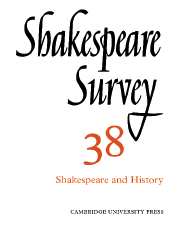Book contents
- Frontmatter
- Shakespeare’s History Plays: 1952–1983
- Shakespeare and History: Divergencies and Agreements
- Shakespeare’s Georgic Histories
- The Nature of Topicality in Love’s Labour’s Lost
- The Tragic Substructure of the Henry IV Plays
- Hal and the Regent
- The Rite of Violence in I Henry IV
- The Fortunes of Oldcastle
- Hand D in Sir Thomas More: An Essay in Misinterpretation
- Livy, Machiavelli, and Shakespeare’s Coriolanus
- Henry VIII and the Ideal England
- The Strangeness of a Dramatic Style: Rumour in Henry VIII
- ‘Edgar I Nothing Am’: Figurenposition in King Lear
- ‘Very like a whale’: Scepticism and Seeing in The Tempest
- Shakespeare’s Medical Imagination
- Shakespeare in the Theatrical Criticism of Henry Morley
- Shakespeare Performances in Stratford-upon-Avon and London 1983–4
- The Year's Contributions to Shakespearian Study 1 Critical Studies
- 2 Shakespeare’s Life, Times and Stage
- 3 Editions and Textual Studies
- Index
The Tragic Substructure of the Henry IV Plays
Published online by Cambridge University Press: 28 March 2007
- Frontmatter
- Shakespeare’s History Plays: 1952–1983
- Shakespeare and History: Divergencies and Agreements
- Shakespeare’s Georgic Histories
- The Nature of Topicality in Love’s Labour’s Lost
- The Tragic Substructure of the Henry IV Plays
- Hal and the Regent
- The Rite of Violence in I Henry IV
- The Fortunes of Oldcastle
- Hand D in Sir Thomas More: An Essay in Misinterpretation
- Livy, Machiavelli, and Shakespeare’s Coriolanus
- Henry VIII and the Ideal England
- The Strangeness of a Dramatic Style: Rumour in Henry VIII
- ‘Edgar I Nothing Am’: Figurenposition in King Lear
- ‘Very like a whale’: Scepticism and Seeing in The Tempest
- Shakespeare’s Medical Imagination
- Shakespeare in the Theatrical Criticism of Henry Morley
- Shakespeare Performances in Stratford-upon-Avon and London 1983–4
- The Year's Contributions to Shakespearian Study 1 Critical Studies
- 2 Shakespeare’s Life, Times and Stage
- 3 Editions and Textual Studies
- Index
Summary
In reporting Queen Elizabeth’s conversation with William Lambarde, the Keeper of the Records in the Tower of London, about the staging of Richard II on Saturday, 6 February 1601, most scholars emphasize the Queen’s words, ‘I am Richard II, know ye not that?’ Less often repeated but of much greater significance to the play which gave rise to the exchange and those that followed it, are the Queen’s next words which, in referring to Essex, make significant comment on the dramatic role into which she cast the treacherous earl. ‘He that will forget God,’ she said, ‘will also forget his benefactors . . .’ And Francis Bacon, who was one of the crown prosecutors at the trial which followed the unsuccessful insurrection, left no question as to the ultimate condemnation of any who would defy divine authority. In speaking of Sir Gilly Meyrick, one of Essex’s supporters, Bacon said, ‘So earnest hee was to satisfie his eyes with the sight of that tragedie which hee thought soone after his lord should bring from the stage to the state, but that God turned it upon their owne heads.’ Both of these speakers seem less concerned with Shakespeare’s hero than they are with the nature of Elizabeth’s antagonist and with divine providence. ‘That tragedie’ which was to have been brought from ‘the stage to the state’ would seem to refer as much to the usurpation of Richard’s throne as to his downfall and death, perhaps more.
- Type
- Chapter
- Information
- Shakespeare Survey , pp. 61 - 68Publisher: Cambridge University PressPrint publication year: 1986



